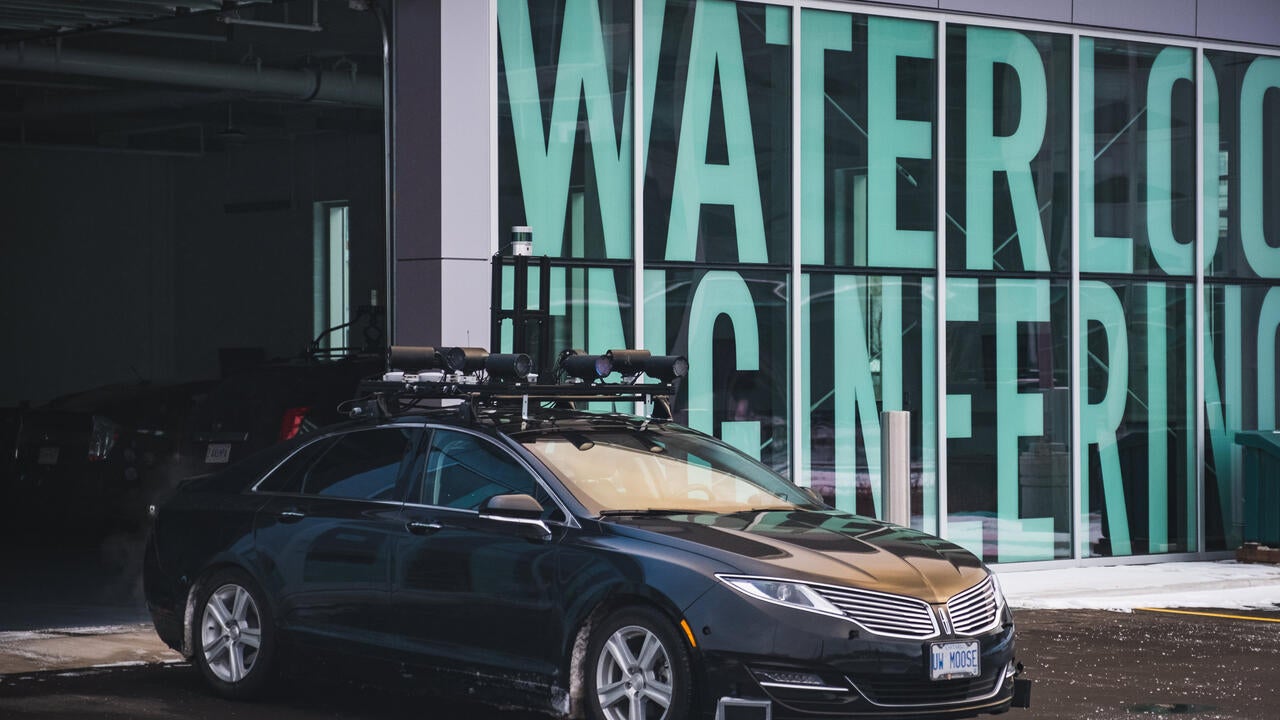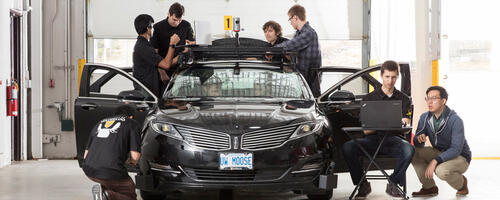
Gearing up Autonomoose for a Canadian first
Waterloo researchers expect to test an autonomous car for the first time on a public road anywhere in the country

Waterloo researchers expect to test an autonomous car for the first time on a public road anywhere in the country
By Brian Caldwell Faculty of EngineeringA little bit of history should be made this fall on Colby Drive, an otherwise unremarkable loop of pavement in an industrial area of Waterloo.
After more than a year of painstaking work, it’s where researchers at the University of Waterloo expect to become the first university-based team to test an autonomous car – cleverly nicknamed Autonomoose by students - on any public road in Canada.
If all goes according to plan, the modified Lincoln MKZ hybrid sedan will drive itself around a two-kilometre route and give dozens of people involved in the ambitious effort reason to celebrate.
“We’re going to be super excited because the first public road test represents a major milestone,” says Krzysztof Czarnecki, co-leader of the autonomous vehicle (AV) project.
Getting to this point has taken steady progress since Waterloo was named by the Ontario government in November as one of the first three groups approved to do testing on public roads under an AV pilot program.
Prior to that, researchers partnered with Renesas Electronics America to help develop an automated car for demonstrations in January on a closed course at the high-profile Consumer Electronics Show in Las Vegas.

Members of the Waterloo Engineering autonomous vehicle project work on Autonomoose, the nickname for their Lincoln MKZ hybrid sedan.
That an actual road test in autonomous mode is taking this long to safely pull off is evidence of just how complicated it is to develop and integrate all the technology required to replace a human driver behind the wheel.
A core team of more than 60 professors, post-doctoral fellows, research engineers, research associates and graduate students has concentrated so far on training the computer software at the heart of Autonomoose to recognize and track other vehicles and pedestrians.
In conjunction with its cameras, laser scanners and other sensory devices, that ability is crucial for the car to not only make its way around the Colby loop, but perform functions such as stopping and starting, yielding to other vehicles and steering around parked cars.
“This project is extremely challenging because of the sheer complexity and volume of problems that have to be solved,” says Czarnecki, an electrical and computer engineering professor. “We’re building the whole system, from the sensors down to telling the brakes, throttle and steering what to do.”
Next steps in the gradual development process involve expanding and refining the car’s ability to perceive its surroundings, and using an artificial intelligence technique known as reinforcement learning to begin teaching its all-important brain to make behavioural decisions on its own.
Researchers hope to have gone far enough down those paths by the end of the year for Autonomoose to travel, in self-driving mode, all the way to campus from a test track several kilometres away.
That complex trip, a huge step up from quiet Colby Drive, would require navigating signalled intersections and roundabouts on multi-lane city streets while surrounded by the usual mix of cars, trucks, motorcycles, bicycles and pedestrians.
“If we are able to do that, it would be amazing,” says Czarnecki, who heads the three-year project with Steven Waslander, a mechanical and mechatronics engineering professor and director of the Waterloo Autonomous Vehicles Laboratory (WAVELab).
Work to date has also included recording data via the car’s sensors on about 50 kilometres of local roads, creating a virtual version of the campus ring road for eventual decision-making training and simulated driving in the video game Grand Theft Auto.
While it may not live up to some of the over-heated hype surrounding autonomous vehicles, Czarnecki says the progress at Waterloo has been extremely encouraging.
“It’s a constant journey taking a lot of baby steps,” he says, “but there is a huge difference between a basic system like we had in Las Vegas and a system that actually begins to understand its surroundings.”

Read more
Here are the people and events behind some of this year’s most compelling Waterloo stories

Engineering master's student Nayeema Nonta (left), one of the three paper authors, and her supervisor, Dr. Sirisha Rambhatla, in a large server room with the computer power needed to develop their new LLM training technique. (University of Waterloo)
Read more
Waterloo researchers develop highly efficient AI training system that paves the way for cheaper, greener “intelligent partners”

Read more
Engineering researchers team up to tackle the plastics pollution problem with microbial innovation and engineering design
The University of Waterloo acknowledges that much of our work takes place on the traditional territory of the Neutral, Anishinaabeg, and Haudenosaunee peoples. Our main campus is situated on the Haldimand Tract, the land granted to the Six Nations that includes six miles on each side of the Grand River. Our active work toward reconciliation takes place across our campuses through research, learning, teaching, and community building, and is co-ordinated within the Office of Indigenous Relations.